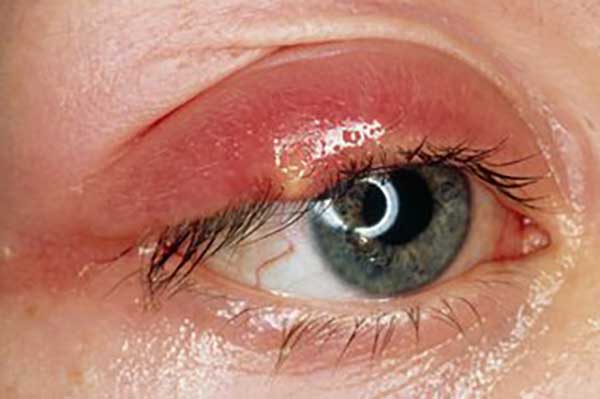Swollen Eyelid: Causes, Treatment & Home Remedies
Although the eyelids appear to be part of the rest of our skin, they have quite complex anatomy compared to other skin structures. It has multiple sebaceous glands, additional tear glands, sweat glands, cilia and other cutaneous and subcutaneous muscle tissues. Since these are soft tissues, any inflammation in these structures will cause the eyelid to swell. Another common reason for swollen eyelids is fluid build-up in the soft tissue of the eyelid. Therefore, swollen eyelids are usually a symptom of a disease rather than a disease itself. Although the eyelid is less than a millimetre thick, the tissue is very elastic, so the eyelids tend to develop larger swellings. Common causes of swollen eyelids
Stye: At the edge of the eyelid there are several sebaceous glands that continuously secrete the oil layer of our tear film. This oil is necessary to prevent the evaporation or immediate flow of our tears; We need tears to stay in the eye to keep it hydrated. Sometimes these sebaceous glands become clogged, preventing sebum secretion. The opening becomes inflamed and creates a painful swelling called a stye. There may be one or more styes on the upper or lower eyelid.
Chalazion: Once the infection of a stye has cleared, the painless remaining lump is called a chalazion. Chalazion does not cause any specific symptoms other than swelling over the affected eyelid and there is no medical treatment for it. Surgical drainage is required to reduce swelling.
Conjunctivitis: We all know this condition, which is a common cause of red eyes. It can be a bacterial or viral infection. Conjunctivitis occurs when the transparent layer called the conjunctiva, which is attached to the back of the eyelid and comes into contact with the surface of the eye, becomes inflamed. Because of this inflammation, fluid can build up in the eyelids, which can lead to swelling, redness, and sticky discharge.
Orbital Cellulitis: The orbits are the cranial cavities in which our eyeballs are located. There are soft and fatty tissues around our eyeballs that cushion the eyeball and eye muscles and maintain orbital volume. Some of these tissues are also located directly behind our eyelids. Orbital cellulitis is usually caused by an insect bite. Along with the swelling of the eyelids, the patient feels fever and there may also be swelling in the white part of the eye. This condition requires immediate treatment by a doctor.
Allergies: Allergies are caused by the body’s reaction to certain allergens that enter our body. Eye allergies are sometimes accompanied by a cold, a runny nose and, rarely, a fever. Due to the allergic reaction, fluid retention can occur in the eyelid tissue, which can lead to swelling of the eyelids. Patients usually suffer from itchy eyes and the constant need to rub them.
Blepharitis: Inflammation of the eyelid itself also causes swelling, which can be uncomfortable. The edges of the eyelids appear swollen and red, accompanied by constant itching and discomfort. It is easily treated by prescribing eye drops, hot promotions and maintaining eyelid hygiene.
Inflammation of the eyelids rarely leads to blurred vision, as milder forms of inflammation usually lie outside the patient’s visual axis. However, larger swellings can put pressure on the cornea, the frontmost part of the eye, and lead to reduced vision.
Treatment Options to Reduce Swollen Eyelids:
Treatment for swollen eyelids depends on the cause. If there is a bacterial infection, antibiotics are prescribed. If a skin infection is responsible for the swelling, the skin should be treated, not the eye itself. In certain cases, prescription medications such as topical ointments or oral medications may be necessary.
If swollen eyelids are the result of an allergy, your doctor will prescribe allergy medication and may recommend cold compresses for the affected eyelids.
Home remedies for swollen eyelids:
– Use clean tissue paper or cotton balls to wipe discharge from the eyelids.
– Apply a cold compress to swollen eyelids by wrapping an ice cube in a clean cloth and placing it over the eye.
– If you wear contact lenses, remove them immediately.
– Elevate the head slightly with a pillow to reduce fluid retention.
– Consult your eye doctor if symptoms persist after a few days.
Emergency care for swollen eyelids:
– Remove contact lenses immediately if you wear them.
– If you experience double vision and swelling of the eyelids, seek immediate help at the nearest eye clinic.
– Inform an eye clinic if sudden loss of vision occurs.
– Applying a cold compress to swollen eyes can help relieve symptoms.
– If you feel severe pain behind the eyeball and also the affected eye appears larger than the other, seek help from an eye clinic immediately.
Frequently Asked Questions:
Q – What is the fastest way to heal a swollen upper eyelid?
Applying a cold compress to the swelling will relieve the symptoms caused by the swelling.
Q – What causes sudden swelling of the eyelids?
Some of the most common causes of sudden swelling of the eyelids may include styes, chalazoids, conjunctivitis, orbital cellulitis, and allergies.
Q – Is heat or cold better for swollen eyelids?
It depends on the cause of the swelling. In general, a cold compress helps reduce swelling.
Q – Which antibiotic helps against swollen eyelids?
Chloramphenicol is a commonly used antibiotic for swollen eyelids; However, always consult your eye doctor before self-medicating.
Q – When should you see a doctor to treat swollen eyelids?
Sudden loss of vision, pain behind the eye, inability to move the affected eye as freely as you, fever and persistent discharge are some of the symptoms that require immediate medical attention.

